This site uses cookies as defined in our Cookie Policy, by continuing to use this site you agree to their use.
Continue
| Arrive | Depart | ||||||
| 2nd02 | AprApr | 202828 | Mahé, Seychelles, embark on the Silver Shadow | ||||
Like jade-coloured jewels in the Indian Ocean, the more than 100 Seychelles Islands are often regarded as the Garden of Eden. Lying just four degrees south of the equator, the Seychelles are some 1,000 miles (1,610 km) from the nearest mainland Africa. Little more than 200 years ago, all 115 islands were uninhabited. Then in 1742 a French ship dispatched from Mauritius sailed into one of the small bays. Captain Lazare Picault was the first to explore these unnamed islands. He encountered breathtaking vistas of rugged mountains, lagoons, coral atolls, splendid beaches and secluded coves. After Picault sailed away, the islands remained untouched for the next 14 years. Then France took possession of the seven islands in the Mahé group. During an expedition Captain Morphey named them the Sechelles, in honour of Vicomte Moreau de Sechelles. This name was later anglicised to Seychelles. The first settlers arrived at St. Anne’s Island in 1770; 15 years later the population of Mahé consisted of seven Europeans and 123 slaves. Today there are about 80,000 Seychellois, the majority of whom live on Mahé; the rest are scattered in small communities throughout the archipelago. The people are a fusion of three continents - Africa, Asia and Europe. This has created a unique culture and the use of three languages - Creole, French and English. Mahé is the largest island in the archipelago and the location of the capital, Victoria. Ringed by steep, magnificent mountains, few capitals can claim a more beautiful backdrop. The town features a mixture of modern and indigenous architecture; it is the centre of business and commerce thanks to the extensive port facilities. Noteworthy sites in Victoria are the museum, cathedral, government house, clock tower, botanical gardens and an open-air market. The major attractions are found outside of town where the island’s quiet, lazy atmosphere delights visitors. With 68 pristine, white sand beaches, Mahé boasts more beaches and tourist facilities than any of the other Seychelles Islands. Beautiful and remote Mahé with its green-clad mountains and palm-fringed beaches is indeed an island of abundance; pleasant surprises are around every bend in the trail. Come ashore and discover for yourself this marvellous island paradise. Few places on Earth can claim to have been as blessed by nature as Mahe. Set in the remote Seychelles archipelago over 1,500 kilometres east of Mombasa, Mahe is largest of the 115 islands and is home to so many stunning attractions you won’t know where to begin. For many the Seychelles are the destination of a lifetime. Cerulean seas, miles and miles of beach, lush, tropical jungle and surreal, natural beauty as far as the eye can see. Not only does Mahe boast 68 pristine beaches, it is dominated by the towering peaks of the Morne Seychellois National Park. This splendid National Park takes up over 20% of the island and is home to a vast amount of endemic flora and fauna, including the ultra-rare Seychelles Scops-owl. Unsurprisingly, the crystal clear waters are a diver’s heaven, promising a colourful cornucopia of underwater life, regardless of how experienced you are. Despite the island being visited in 1609 by the British, Mahe did not feature on any maps until 1742, when Frenchman Lazare Picault explored the as yet unnamed islands. However, it took a further 14 years for the French to lay claim to the islands, with the arrival of naval ship Le Cerf, captained by Corneille Morphey who christened the archipelago after Vicomte Moreau de Sechelles. He did this by setting down a Stone of Possession, which is on display in the National Museum. The first settlers arrived in 1770 and 15 years later the population had swelled to 130 – 7 Europeans and 123 slaves. Today, there are 80,000 Seychellois. | |||||||
| 3rd03 | AprApr | 202828 | Mahé, Seychelles | 05:00 | |||
Like jade-coloured jewels in the Indian Ocean, the more than 100 Seychelles Islands are often regarded as the Garden of Eden. Lying just four degrees south of the equator, the Seychelles are some 1,000 miles (1,610 km) from the nearest mainland Africa. Little more than 200 years ago, all 115 islands were uninhabited. Then in 1742 a French ship dispatched from Mauritius sailed into one of the small bays. Captain Lazare Picault was the first to explore these unnamed islands. He encountered breathtaking vistas of rugged mountains, lagoons, coral atolls, splendid beaches and secluded coves. After Picault sailed away, the islands remained untouched for the next 14 years. Then France took possession of the seven islands in the Mahé group. During an expedition Captain Morphey named them the Sechelles, in honour of Vicomte Moreau de Sechelles. This name was later anglicised to Seychelles. The first settlers arrived at St. Anne’s Island in 1770; 15 years later the population of Mahé consisted of seven Europeans and 123 slaves. Today there are about 80,000 Seychellois, the majority of whom live on Mahé; the rest are scattered in small communities throughout the archipelago. The people are a fusion of three continents - Africa, Asia and Europe. This has created a unique culture and the use of three languages - Creole, French and English. Mahé is the largest island in the archipelago and the location of the capital, Victoria. Ringed by steep, magnificent mountains, few capitals can claim a more beautiful backdrop. The town features a mixture of modern and indigenous architecture; it is the centre of business and commerce thanks to the extensive port facilities. Noteworthy sites in Victoria are the museum, cathedral, government house, clock tower, botanical gardens and an open-air market. The major attractions are found outside of town where the island’s quiet, lazy atmosphere delights visitors. With 68 pristine, white sand beaches, Mahé boasts more beaches and tourist facilities than any of the other Seychelles Islands. Beautiful and remote Mahé with its green-clad mountains and palm-fringed beaches is indeed an island of abundance; pleasant surprises are around every bend in the trail. Come ashore and discover for yourself this marvellous island paradise. Few places on Earth can claim to have been as blessed by nature as Mahe. Set in the remote Seychelles archipelago over 1,500 kilometres east of Mombasa, Mahe is largest of the 115 islands and is home to so many stunning attractions you won’t know where to begin. For many the Seychelles are the destination of a lifetime. Cerulean seas, miles and miles of beach, lush, tropical jungle and surreal, natural beauty as far as the eye can see. Not only does Mahe boast 68 pristine beaches, it is dominated by the towering peaks of the Morne Seychellois National Park. This splendid National Park takes up over 20% of the island and is home to a vast amount of endemic flora and fauna, including the ultra-rare Seychelles Scops-owl. Unsurprisingly, the crystal clear waters are a diver’s heaven, promising a colourful cornucopia of underwater life, regardless of how experienced you are. Despite the island being visited in 1609 by the British, Mahe did not feature on any maps until 1742, when Frenchman Lazare Picault explored the as yet unnamed islands. However, it took a further 14 years for the French to lay claim to the islands, with the arrival of naval ship Le Cerf, captained by Corneille Morphey who christened the archipelago after Vicomte Moreau de Sechelles. He did this by setting down a Stone of Possession, which is on display in the National Museum. The first settlers arrived in 1770 and 15 years later the population had swelled to 130 – 7 Europeans and 123 slaves. Today, there are 80,000 Seychellois. | |||||||
| 3rd03 | AprApr | 202828 | Praslin Island, Seychelles | 08:00 | 18:00 | ||
Forty kilometers (25 miles) northeast of Mahé, Praslin is just a 15-minute flight or 45-minute ferry ride away. Praslin, at 11 km (7 miles) long and 4 km (2.5 miles) wide, is the second-largest island in the Seychelles. First settled as a hideaway by pirates and Arab merchants, the island's original name, Isle de Palmes, bears testament to its reputation as home of the Vallée de Mai UNESCO World Heritage Site: the only place in the world where the famous Coco de Mer, the world's heaviest nut, grows abundantly in the wild. Praslin's endemic palm forests shelter many rare species, and the island is a major bird-watching destination. Surrounded by a coral reef, majestic bays, and gorgeous beaches, Praslin is much quieter and less developed than Mahé. With few real "sights," the pleasures of Praslin largely involve relaxing in or exploring its stunning beaches and fantastical forests. Loved by those who like their paradise just as nature intended, Praslin is one the Seychelles’ most beautiful islands. And why? Anse Lazio – the island’s beach is a repeated winner for world’s best, making the island is a pull for travellers who want to go the extra mile to find an unblemished island nirvana. Praslin might be the second largest of the Seychelles islands but at just 11 kilometres long and 4 kilometres wide, it is still very small. The difficulty in getting to it (other than arrival by sea there is a small airport that only flies to and from Mahe) means there are no modern attractions – on the contrary, entertainment comes very much in the flora and fauna of the land and surrounding sea. The island’s original name is Isle de Palmes and it’s not hard to see why. The lush jungle that makes up the island’s interior has it all; bubbling brooks, winding paths and towering trees that provide welcome respite from the sun. This is the true heart of the island; not only is the jungle home to the endemic Black Parrot (fewer than 1,000 of these birds are in existence) but also the famous Coco de Mer, the world's heaviest nut, grows abundantly in the wild. The nut is the stuff of legends. Early beliefs were that the palm grew under the Indian Ocean and that its fruit held healing powers. Even when it emerged that the tree did in fact grow on dry land, it still held mystique; the new folklore was that in order for the 25 kilo nut to grow, male and female trees had to embrace on a stormy night. | |||||||
| 4th04 | AprApr | 202828 | At Sea | ||||
| 5th05 | AprApr | 202828 | At Sea | ||||
| 6th06 | AprApr | 202828 | At Sea | ||||
| 7th07 | AprApr | 202828 | At Sea | ||||
| 8th08 | AprApr | 202828 | At Sea | ||||
| 9th09 | AprApr | 202828 | Muscat, Oman | ||||
Oman's capital city is hemmed in on one side by spectacular jagged-peaked mountains and on the other by royal blue sea. The architecture is a traditional, sophisticated arabesque blend of white-washed, low-rise buildings surrounded by manicured palms, intricately designed domes set atop the minarets of the mosques, sand-colored villas, a surprising blend of modern art installations, like a giant incense burner that towers over the Corniche, and ancient forts set in the rocky hills. Though tradition abounds, from distinct, local cuisine to the widely worn national dress, the dishdasha, Muscat is a completely modern city, featuring opulent luxury hotels, international restaurants, excellent cellular and data service, sprawling shopping malls, pristine beaches, lively nightlife, world-class performing arts, and a highly educated population, most of whom speak English, Arabic, and often Hindi. Muscat is the ideal base for exploring other areas of the country since many of the most desirable destinations are within a few hours' drive. Oman’s capital rests overlooking the coast of the Gulf of Oman, tucked away among the country’s mountains. Discover a city surrounded by neat gardens - with streets lined by palm trees and crumbling Portuguese forts providing a tangible link to the past. Explore an elegant array of domes, minarets and marbled Arabic archways, as you’re immersed in a city where a traditional conservative outlook mingles with a pragmatic modern approach. Despite a relative boom in recent years, Muscat has clung to its old-world Arabian charm. | |||||||
| 10th10 | AprApr | 202828 | Muscat, Oman | ||||
Oman's capital city is hemmed in on one side by spectacular jagged-peaked mountains and on the other by royal blue sea. The architecture is a traditional, sophisticated arabesque blend of white-washed, low-rise buildings surrounded by manicured palms, intricately designed domes set atop the minarets of the mosques, sand-colored villas, a surprising blend of modern art installations, like a giant incense burner that towers over the Corniche, and ancient forts set in the rocky hills. Though tradition abounds, from distinct, local cuisine to the widely worn national dress, the dishdasha, Muscat is a completely modern city, featuring opulent luxury hotels, international restaurants, excellent cellular and data service, sprawling shopping malls, pristine beaches, lively nightlife, world-class performing arts, and a highly educated population, most of whom speak English, Arabic, and often Hindi. Muscat is the ideal base for exploring other areas of the country since many of the most desirable destinations are within a few hours' drive. Oman’s capital rests overlooking the coast of the Gulf of Oman, tucked away among the country’s mountains. Discover a city surrounded by neat gardens - with streets lined by palm trees and crumbling Portuguese forts providing a tangible link to the past. Explore an elegant array of domes, minarets and marbled Arabic archways, as you’re immersed in a city where a traditional conservative outlook mingles with a pragmatic modern approach. Despite a relative boom in recent years, Muscat has clung to its old-world Arabian charm. | |||||||
| 11th11 | AprApr | 202828 | Muscat, Oman | 13:00 | |||
Oman's capital city is hemmed in on one side by spectacular jagged-peaked mountains and on the other by royal blue sea. The architecture is a traditional, sophisticated arabesque blend of white-washed, low-rise buildings surrounded by manicured palms, intricately designed domes set atop the minarets of the mosques, sand-colored villas, a surprising blend of modern art installations, like a giant incense burner that towers over the Corniche, and ancient forts set in the rocky hills. Though tradition abounds, from distinct, local cuisine to the widely worn national dress, the dishdasha, Muscat is a completely modern city, featuring opulent luxury hotels, international restaurants, excellent cellular and data service, sprawling shopping malls, pristine beaches, lively nightlife, world-class performing arts, and a highly educated population, most of whom speak English, Arabic, and often Hindi. Muscat is the ideal base for exploring other areas of the country since many of the most desirable destinations are within a few hours' drive. Oman’s capital rests overlooking the coast of the Gulf of Oman, tucked away among the country’s mountains. Discover a city surrounded by neat gardens - with streets lined by palm trees and crumbling Portuguese forts providing a tangible link to the past. Explore an elegant array of domes, minarets and marbled Arabic archways, as you’re immersed in a city where a traditional conservative outlook mingles with a pragmatic modern approach. Despite a relative boom in recent years, Muscat has clung to its old-world Arabian charm. | |||||||
| 12th12 | AprApr | 202828 | Khasab, Oman | 08:00 | 18:00 | ||
See Khasab’s jutting fjords, and the dolphins playing in the emerald waters, and it’s forgivable to think you’ve stumbled across a surreal Norway. The burning sun and scorched earth, serve as a constant reminder that you're a long way from Europe, however - although the Portuguese roots mean there's a colonial tint to the city. Sitting on the Northern coast of Oman, reaching across towards Iran, this is an isolated and fascinating destination to explore. The remote location, and limited infrastructure here, until recent times, means Khasab has been left to live life at its own pace, and the city sings to its own song sheet. Even now you can see a blind eye being turned to the smugglers who whisk electronics across the Gulf to Iran, in small speed boats. It may be known as the Norway of Arabia - in reference to the spectacular fjords that cut and shape the Musandam Peninsular - but Khasab's scorching sun and desert landscape is a constant reminder that you're a long way from Europe. Sitting isolated on Oman’s Northern coast - cut off by a slice of the United Arab Emirates' territory - this small city has a dreamy introverted atmosphere - until you head out in a 4X4 to slip and slide across its rip-roaring mountain scenery that is. Explore the incredible desert fjords and folding sandy mountains by boat and be on the look out for the rubbery noses of bottlenose and humpback dolphins poking through the water. Legendarily friendly and curious don’t be surprised to see them swimming through the blue waters with you displaying all of their aquatic athletic prowess as you sail by traditional wooden dhow. Cruise up along the Strait of Hormuz between Oman and Iran and marvel at the long stretches of dramatic golden fjord scenery. Back on land learn of local history at Khasab Castle which was originally built in the 17th century by the Portuguese to defend the narrowing of the Persian Gulf at this highly strategic point. It's accompanied by a museum which depicts local life here back through the ages. Or drive out to Bedouin villages and hold on tight during the white-knuckle drive up to the viewpoint at Khawr Najd - where sweeping views of the flayed fjords unveil themselves. | |||||||
| 13th13 | AprApr | 202828 | Abu Dhabi, United Arab Emirates | ||||
Just a few decades ago, Abu Dhabi, the island capital of the United Arab Emirates, was a small fishing village with houses made of mud-brick and palm fronds. Today, as a result of revenue from oil, Abu Dhabi is one of the world's richest cities, with wide, tree-lined okulevards, lush green parks, gushing fountains and imposing skyscrapers. Somewhat of a dichotomy, Abu Dhabi is a combination of ultra-modern sophistication and Arab mystique, with friendly and hospitable people offering a warm welcome to visitors. Abu Dhabi's history originated in the 18th century, when, according to legend, a group of tribesmen pursuing a gazelle came upon a freshwater well which they named Abu Dhabi, or "Father of the Gazelle". In the 19th century, the first fort was built over this well by a sheikh of the Al-Nahyan dynasty. The fort's name is Al Husn Palace, also known as Old or White Fort, and it is one of the few buildings in Abu Dhabi that is more than 25 years old. Its whitewashed walls are eye-catching amid the backdrop of today's skyscrapers. Presently, it is home to the Cultural Foundation and serves as a documents centre. Abu Dhabi had little significance until the discovery of vast oil reserves in the late 1950s and early 1960s. In the years following, the city's economy and infrastructure developed rapidly and changed Abu Dhabi beyond recognition. Emerging from the desert’s sands like a mirage, Abu Dhabi's bold, brash and brilliant skyline continues to reach new heights. The extravagance on show can be dizzying at times, but it’s counterpointed by authentic history and culture, and majestic religious statements. You’ll shrink before the scale of the 50 exquisite, pearl-white domes of the Sheikh Zayed Mosque, which is the UAE's largest and most revered religious space. A healthy pearl trade, and strategic location, brought prosperity in the 19th century, before the discovery of rich oil reserves propelled the city giddily skywards in the latter half of the 20th century. Nowadays, palatial hotels tower above dazzling ocean and white sands, while ever-reliable weather and remarkable extravagances, make Abu Dhabi a location of unbridled opulence and intrigue. The city's cultural scene is also burgeoning, with a stunning Louvre outpost recently opening for business. Find your bearings by ascending 300 metres to the heights of the Etihad Towers' viewing platform - where you can butter scones while enjoying a 'high tea' in every sense. The relentlessly glorious weather makes the coral-blue sea's sparkle ever-tempting, and at Saadiyat Public Beach you’ll find clear blue waves lapping soft, sugar-white sand. Wade out to enjoy bath-like temperatures of 30 degrees. The Corniche, meanwhile, is a sweeping coastal walkway, stretching for eight kilometres and offering rich views of the coral-blue ocean back-dropped by jagged skyscrapers. | |||||||
| 14th14 | AprApr | 202828 | Abu Dhabi, United Arab Emirates | 18:00 | |||
Just a few decades ago, Abu Dhabi, the island capital of the United Arab Emirates, was a small fishing village with houses made of mud-brick and palm fronds. Today, as a result of revenue from oil, Abu Dhabi is one of the world's richest cities, with wide, tree-lined okulevards, lush green parks, gushing fountains and imposing skyscrapers. Somewhat of a dichotomy, Abu Dhabi is a combination of ultra-modern sophistication and Arab mystique, with friendly and hospitable people offering a warm welcome to visitors. Abu Dhabi's history originated in the 18th century, when, according to legend, a group of tribesmen pursuing a gazelle came upon a freshwater well which they named Abu Dhabi, or "Father of the Gazelle". In the 19th century, the first fort was built over this well by a sheikh of the Al-Nahyan dynasty. The fort's name is Al Husn Palace, also known as Old or White Fort, and it is one of the few buildings in Abu Dhabi that is more than 25 years old. Its whitewashed walls are eye-catching amid the backdrop of today's skyscrapers. Presently, it is home to the Cultural Foundation and serves as a documents centre. Abu Dhabi had little significance until the discovery of vast oil reserves in the late 1950s and early 1960s. In the years following, the city's economy and infrastructure developed rapidly and changed Abu Dhabi beyond recognition. Emerging from the desert’s sands like a mirage, Abu Dhabi's bold, brash and brilliant skyline continues to reach new heights. The extravagance on show can be dizzying at times, but it’s counterpointed by authentic history and culture, and majestic religious statements. You’ll shrink before the scale of the 50 exquisite, pearl-white domes of the Sheikh Zayed Mosque, which is the UAE's largest and most revered religious space. A healthy pearl trade, and strategic location, brought prosperity in the 19th century, before the discovery of rich oil reserves propelled the city giddily skywards in the latter half of the 20th century. Nowadays, palatial hotels tower above dazzling ocean and white sands, while ever-reliable weather and remarkable extravagances, make Abu Dhabi a location of unbridled opulence and intrigue. The city's cultural scene is also burgeoning, with a stunning Louvre outpost recently opening for business. Find your bearings by ascending 300 metres to the heights of the Etihad Towers' viewing platform - where you can butter scones while enjoying a 'high tea' in every sense. The relentlessly glorious weather makes the coral-blue sea's sparkle ever-tempting, and at Saadiyat Public Beach you’ll find clear blue waves lapping soft, sugar-white sand. Wade out to enjoy bath-like temperatures of 30 degrees. The Corniche, meanwhile, is a sweeping coastal walkway, stretching for eight kilometres and offering rich views of the coral-blue ocean back-dropped by jagged skyscrapers. | |||||||
| 15th15 | AprApr | 202828 | Doha, Qatar | 08:00 | 18:00 | ||
Doha (population 700,000) is the capital of the State of Qatar, an emirate occupying the small Qatar Peninsula bordered by Saudi Arabia to the south and otherwise surrounded by the Persian Gulf. Qatar was ruled by many different powers through the centuries, in fact historians have traced human habitation dating back 5000 years. From its earliest history, Qatar was a very important trade route connecting Mesopotamia and the Indus Valley. Among its occupiers were the Portuguese, the Ottomans and finally the British during the turbulent years of the 20th century. Qatar gained independence in 1971, and with resources from oil exportation, His Highness Sheikh Khalifa Bin Hamad made improvements in social programmes including education, health and housing. In 1995, his son, His Highness Sheikh Hamad Bin Khalifa Al-Thani assumed the throne and brought with him a modern and progressive approach that quickly transformed the country. Doha, home to 80 percent of the country’s population, was founded under the name of Al-Bida in 1850. It became the capital of the British protectorate of Qatar in 1916. When the nation gained its independence, Doha remained the capital. During the early 20th century, much of Qatar’s economy depended on fishing and pearling. But after the introduction of Japanese cultured pearls, Doha and the whole region suffered a decline. Only when oil was discovered, prosperity returned following World War II. Today, the country produces over 800,000 barrels of oil daily. Doha is situated halfway down the east coast of the peninsula. It is an intriguing mixture of old and new, with ultra modern architecture next to traditional souqs and historic forts. It boasts a university and the Qatar National Museum (currently closed for renovation), which opened 1975 in what was originally the ruler’s palace. As the country’s cultural and commercial centre, Doha enjoys excellent communications with the outside world through its modern seaport, airport and telephone links. The Al Jazeera Arabic satellite television news channel began broadcasting in 1996 with its headquarters in Doha. While Arabic is the official language, English is widely spoken. Please Note: Conservative dress is required when going ashore. As a rule, women should not wear miniskirts, shorts or sleeveless tops and men should always wear a shirt in public. Please do not photograph people without their permission, especially women.You may not take pictures of government buildings, embassies or anything military in nature, including airports. Extravagant shopping malls gleaming skyscrapers and mosques studded with intricate carvings all contribute to the Pearl of Qatar's flourishing skyline. A futuristic vision kept grounded by its heritage this sprawling metropolis's ambitious structures echo the ancient Arabic art that long preceded its rise. Explore the luxurious and fascinating tapestry of interwoven extravagance and tradition that is Doha's trademark as you soak up the sun sea and skyline of this ever-sparkling city. Founded in the 1820s Doha has grown apace from its pearl-farming village origins. Despite the vertical ambitions you can quickly lose yourself in Doha's tight web of alleyways as you delve into the oldest souk in Qatar - which swallows visitors up in a cacophony of bartering and bantering. Goods have traded hands here for over a hundred years and it's still the place to pick out handfuls of fresh dates and nuts or perch at restaurants serving up saloona - a heavily spiced and perfumed broth of lamb and soft aubergine. Wander the Corniche's four-mile parade which unspools at the feet of skyscrapers that glow jewel-like with multicoloured allure as night descends. You'll walk with the vibrant colours of the Persian Bay stretching out next to you. The palm-tree-lined boulevard culminates in the spectacular Museum of Islamic Art which stands proudly like a giant glinting sandcastle. | |||||||
| 16th16 | AprApr | 202828 | Manama, Bahrain | 08:00 | 19:00 | ||
Rising like an oasis in the Persian Gulf, Manamah is no mirage. The capital of Bahrain (with a population of around 150, 000), the city houses almost a quarter of all Bahranis. At times resembling something from 1001 nights and at others like something from the set of a sci-fi futuristic drama Al Manamah is just beginning to get seen on the savvy traveller’s map. Mentioned in Islamic chronicles since 1345 and conquered by the Portuguese in 1521, Manamah is anything except typical. Expect to feast both your eyes and your stomachs here with the quintessence of Muslim hospitality – from delicious bowls laden with love and eons of history to the plethora of genuine, warm invitations to share tea with the locals, hospitality is taken very seriously here. For culture vultures, the Al Fateh Mosque (one of the world’s largest and by far the largest in Bahrain), this is a sight – and site – to see. First and foremost a place of worship that offers tours on the side, it is important to remember that this is a sacred place and traditions and cultures must be respected. Dress modestly, remove your shoes and women should cover their heads – note that garmets will be provided if necessary. However, as one of the most liberal countries in the Middle East, visitors should expect an enthusiastic welcome, inquisitive guides and a huge library to get lost in. Moving on, seven nominated UNESCO World Heritage sites prove the extent of Bahrain’s dedication to conservation of the past. Although only two so far have been approved – the Ancient Harbour and the Pearling Trail that is said to date back to 2,000 BC, one really does get a feeling in Manamah that the past is all around. Rising like an oasis in the Persian Gulf, Manamah is no mirage. Mentioned in Islamic chronicles since 1345 and conquered by the Portuguese in 1521, Manamah is anything except typical. Expect to feast both your eyes and your stomachs here with the quintessence of Muslim hospitality – from delicious bowls laden with love and eons of history to the plethora of genuine, warm invitations to share tea with the locals, hospitality is taken very seriously here. For culture vultures, the Al Fateh Mosque (one of the world’s largest and by far the largest in Bahrain), this is a sight – and site – to see. First and foremost a place of worship that offers tours on the side, it is important to remember that this is a sacred place and traditions and cultures must be respected. Dress modestly, remove your shoes and women should cover their heads – note that garmets will be provided if necessary. However, as one of the most liberal countries in the Middle East, visitors should expect an enthusiastic welcome, inquisitive guides and a huge library to get lost in. Moving on, seven nominated UNESCO World Heritage sites prove the extent of Bahrain’s dedication to conservation of the past. Although only two so far have been approved – the Ancient Harbour and the Pearling Trail that is said to date back to 2,000 BC, one really does get a feeling in Manamah that the past is all around. | |||||||
| 17th17 | AprApr | 202828 | At Sea | ||||
| 18th18 | AprApr | 202828 | Dubai, United Arab Emirates | ||||
Dubai sits on a golden sandy coastline in the Arabian Gulf, where the warm azure waves of the sea meet the desert. A high-rise oasis, this city is a pleasure-dome surrounded by dunes; one of the most fashionable on the planet thanks to its ability to satisfy the needs of legions of demanding vacationers. Dubai is about having fun—and it's one big adult playground.Nature plays her part here, with year-round sunshine, gorgeous beaches, dramatic arid landscapes, and warm waters, but it's the man-made attractions that make Dubai so alluring. You can launch yourself into high-adrenaline desert adventures, diving and water sports, and some of the world's best golf courses. The 5-, 6-, and 7-star hotels offer the ultimate in luxury, and the party scene is hot. Shopping malls are the biggest in the world and are packed full of high-class merchandise. And with hundreds of restaurants with cuisine from around the world, you can munch your way from Mexico to Malaysia.Dubai is an Arab country with a long history as a trading port. Traces of its traditional life, customs, and architecture can still be seen and explored, but today and tomorrow are much more important than yesterday. Almost every building in this metropolis is less than 20 years old and the most dramatic developments—groundbreaking megaprojects—have just been completed or are still under construction.The city is certainly unique. Islam is its anchor, but it has opened its doors to the rest of the world and has invited them in to work, rest, and play, which creates a truly international atmosphere. Unashamedly modern and materialistic, life here takes place at breakneck speed. The landscape is stark, the confidence is sky high, the can-do spirit is palpable, and the bling is in your face. Dubai produces strong reactions in people, but one thing is certain—love it or loathe it—you will not forget it. It is without a doubt, one of the world's true must-see destinations.Shisha: Smoke Without Fire. Emirati men love socializing, but as they don't drink alcohol they get together over coffee and shisha instead of a drink at the bar after work. The shisha, or hookah, is a smoking device, usually made of glass, that filters smoke through water before it reaches the smoker's mouth. Shisha tobaccos are aromatic and are often mixed with apple, cinnamon, or cherry, so their taste isn't as strong as other tobaccos. Smoking shisha is said to induce relaxation—but you'll have to decide if it's for you! Bold, brash and brilliant, Dubai’s explosion of wealth and wonder has created a dizzying, logic-defying desert wonderland. Boundary-pushing architecture, which gently nods to the region’s past - and a relentlessly futuristic vision - makes Dubai one of the most dynamic destinations on the planet. The hyper-speed transformation, from fishing village to glitzy mega-city, has been truly astounding, and it’s hard to avoid feeling humbled, as you stand dwarfed by cloud-scraping architecture, and some of the most elaborate, audacious engineering projects ever conceived. Fuelled by abundant oil reserves, it’s an understatement to say that there is cash to splash here. Whether it’s the gleaming sports cars that purr along the streets, or the luxury shopping malls that are decked out with colossal aquariums and amusement parks, credit cards are flexed with abandon here. The sheer scale of Dubai is stupefying, and the sight of the iconic Burj Khalifa towering over its not inconsiderable neighbours is surreally spectacular. Rocketing up a staggering 830 metres, the world’s tallest building is an elegant affair, tapering up into the ever-blue sky, and headlining this record-breaking city’s list of architectural wonders. The Dubai Fountain performs here each evening - a blur of colour and haze, its waters dance before the almighty tower behind. Dubai isn’t all about the skyward scramble, however, and the Miracle Garden is a vibrant, violent explosion of multicoloured flowery landscaping. Elsewhere, white-sand beaches like Sunset Beach grant sanctuary to take it easy, and enjoy splendid views of instantly recognisable buildings like the Burj Al Arab, and the reclaimed islands that fan out across Dubai’s warm sea waters. Desert landscapes of rolling sand dunes raise the pulses of the adventurous, while fine-dining and lively nightlife makes Dubai a luxury destination that truly has it all. | |||||||
| 19th19 | AprApr | 202828 | Dubai, United Arab Emirates, disembark the Silver Shadow | ||||
Dubai sits on a golden sandy coastline in the Arabian Gulf, where the warm azure waves of the sea meet the desert. A high-rise oasis, this city is a pleasure-dome surrounded by dunes; one of the most fashionable on the planet thanks to its ability to satisfy the needs of legions of demanding vacationers. Dubai is about having fun—and it's one big adult playground.Nature plays her part here, with year-round sunshine, gorgeous beaches, dramatic arid landscapes, and warm waters, but it's the man-made attractions that make Dubai so alluring. You can launch yourself into high-adrenaline desert adventures, diving and water sports, and some of the world's best golf courses. The 5-, 6-, and 7-star hotels offer the ultimate in luxury, and the party scene is hot. Shopping malls are the biggest in the world and are packed full of high-class merchandise. And with hundreds of restaurants with cuisine from around the world, you can munch your way from Mexico to Malaysia.Dubai is an Arab country with a long history as a trading port. Traces of its traditional life, customs, and architecture can still be seen and explored, but today and tomorrow are much more important than yesterday. Almost every building in this metropolis is less than 20 years old and the most dramatic developments—groundbreaking megaprojects—have just been completed or are still under construction.The city is certainly unique. Islam is its anchor, but it has opened its doors to the rest of the world and has invited them in to work, rest, and play, which creates a truly international atmosphere. Unashamedly modern and materialistic, life here takes place at breakneck speed. The landscape is stark, the confidence is sky high, the can-do spirit is palpable, and the bling is in your face. Dubai produces strong reactions in people, but one thing is certain—love it or loathe it—you will not forget it. It is without a doubt, one of the world's true must-see destinations.Shisha: Smoke Without Fire. Emirati men love socializing, but as they don't drink alcohol they get together over coffee and shisha instead of a drink at the bar after work. The shisha, or hookah, is a smoking device, usually made of glass, that filters smoke through water before it reaches the smoker's mouth. Shisha tobaccos are aromatic and are often mixed with apple, cinnamon, or cherry, so their taste isn't as strong as other tobaccos. Smoking shisha is said to induce relaxation—but you'll have to decide if it's for you! Bold, brash and brilliant, Dubai’s explosion of wealth and wonder has created a dizzying, logic-defying desert wonderland. Boundary-pushing architecture, which gently nods to the region’s past - and a relentlessly futuristic vision - makes Dubai one of the most dynamic destinations on the planet. The hyper-speed transformation, from fishing village to glitzy mega-city, has been truly astounding, and it’s hard to avoid feeling humbled, as you stand dwarfed by cloud-scraping architecture, and some of the most elaborate, audacious engineering projects ever conceived. Fuelled by abundant oil reserves, it’s an understatement to say that there is cash to splash here. Whether it’s the gleaming sports cars that purr along the streets, or the luxury shopping malls that are decked out with colossal aquariums and amusement parks, credit cards are flexed with abandon here. The sheer scale of Dubai is stupefying, and the sight of the iconic Burj Khalifa towering over its not inconsiderable neighbours is surreally spectacular. Rocketing up a staggering 830 metres, the world’s tallest building is an elegant affair, tapering up into the ever-blue sky, and headlining this record-breaking city’s list of architectural wonders. The Dubai Fountain performs here each evening - a blur of colour and haze, its waters dance before the almighty tower behind. Dubai isn’t all about the skyward scramble, however, and the Miracle Garden is a vibrant, violent explosion of multicoloured flowery landscaping. Elsewhere, white-sand beaches like Sunset Beach grant sanctuary to take it easy, and enjoy splendid views of instantly recognisable buildings like the Burj Al Arab, and the reclaimed islands that fan out across Dubai’s warm sea waters. Desert landscapes of rolling sand dunes raise the pulses of the adventurous, while fine-dining and lively nightlife makes Dubai a luxury destination that truly has it all. | |||||||
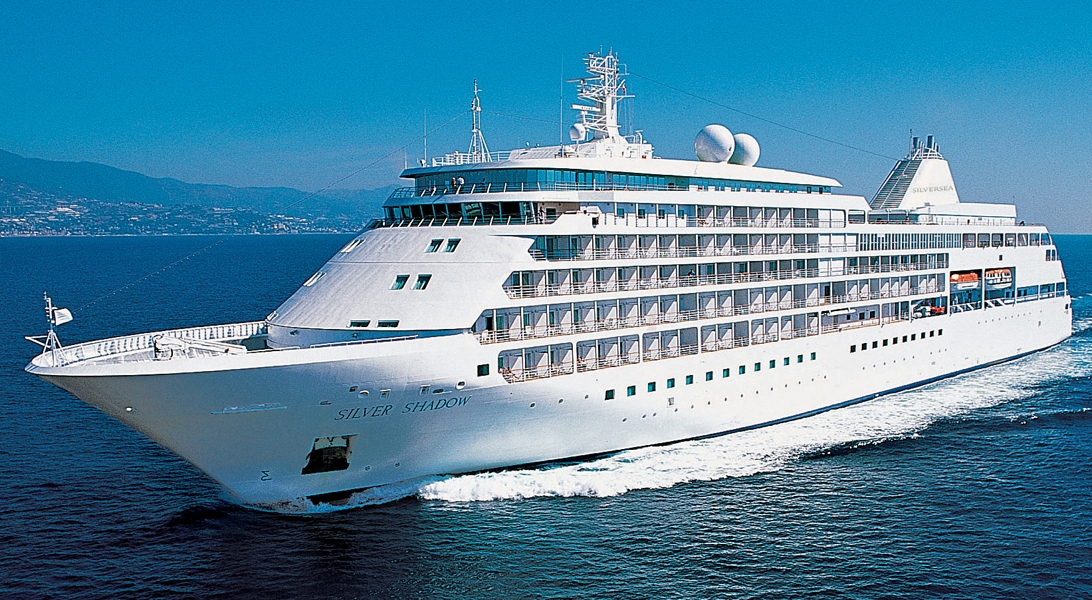







The images shown are for illustration purposes only and may not be an exact representation of what you find on the ship.
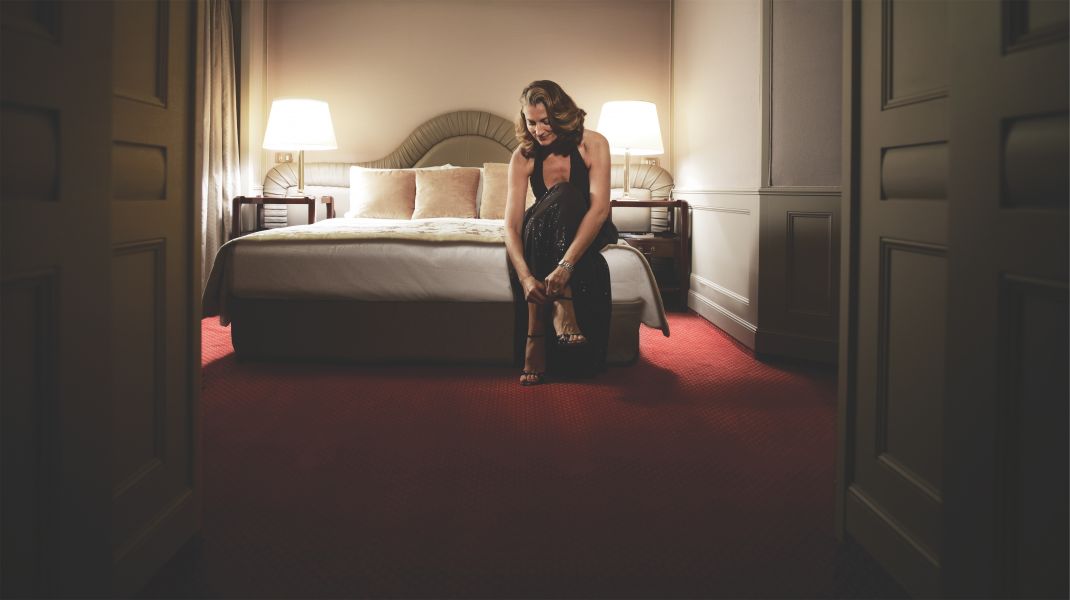
| Grade Code | From | To | |
| G1 | Grand Suite (1 Bedroom) | £31,200 | £31,900 |
| G2 | Grand Suite (2 Bedrooms) | £42,000 | £43,400 |
Expertly designed and exquisitely appointed. Ideal for entertaining friends while you cruise or enjoying a quiet dinner “at home”. Available as a one-bedroom configuration or as two-bedrooms (as illustrated) by adjoining with a Silversea Veranda Suite.
One bedroom: 87-101 sq.m. including veranda
Two bedroom: 133 sq.m. including veranda
Please note that the 3rd guest will sleep on a comfortable sofa bed in the reception area of the suite.
Essentials
Characteristics
Furniture
Media & Communication
Onboard Services
Amenities
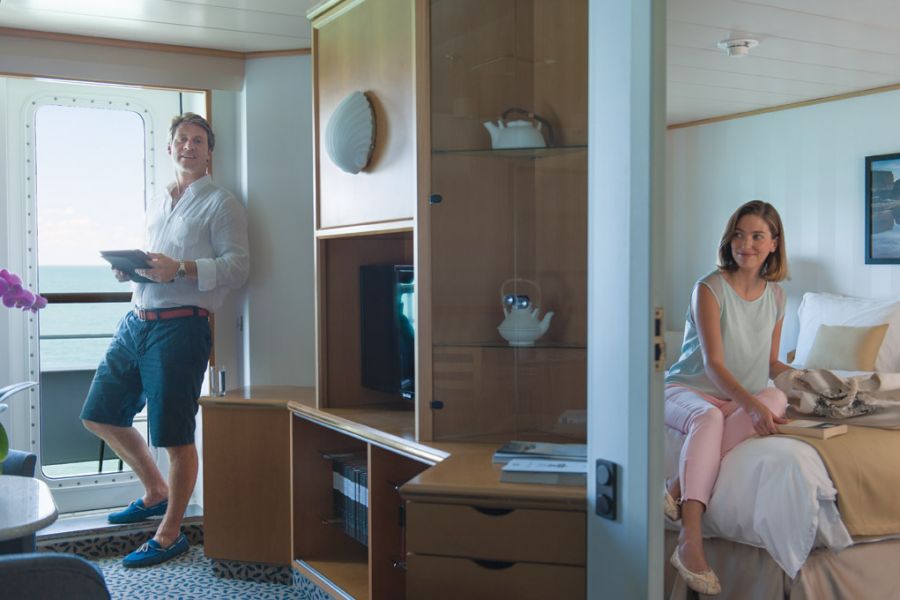
| Grade Code | From | To | |
| ME | Medallion Suite | £22,500 | £23,200 |
A mark of distinction. Sumptuous. Spacious. Rich textures and panoramic views surround you with distinguished luxury. An extravagant suite for an extravagant cruise.
One bedroom: 49 sq.m. including veranda
Please note that the 3rd guest will sleep on a comfortable sofa bed in the reception area of the suite.
Essentials
Characteristics
Furniture
Media & Communication
Onboard Services
Amenities
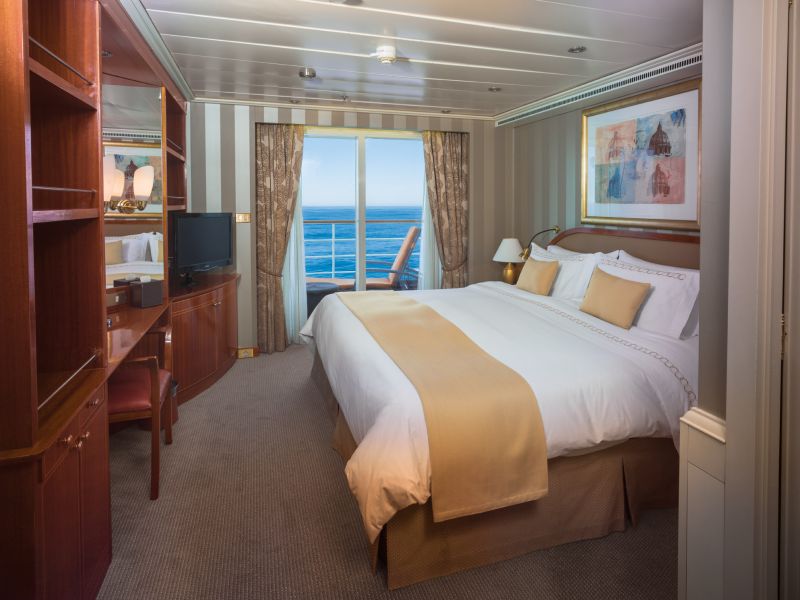
| Grade Code | From | To | |
| O1 | Owner's Suite (1 Bedroom) | £33,600 | £34,300 |
| O2 | Owner's Suite (2 Bedrooms) | £42,600 | £43,900 |
The name Owner's Suite says it all. A stylish apartment. Prestigious and classic. For those who seek the superlative level of space, comfort and service on board. Available as a one-bedroom configuration or as two-bedrooms (as illustrated) by adjoining with a Vista Suite.
One bedroom: 85 sq.m. including veranda
Two bedroom: 117 sq.m. including veranda
Please note that the 3rd guest will sleep on a comfortable sofa bed in the reception area of the suite.
Essentials
Characteristics
Furniture
Media & Communication
Onboard Services
Amenities
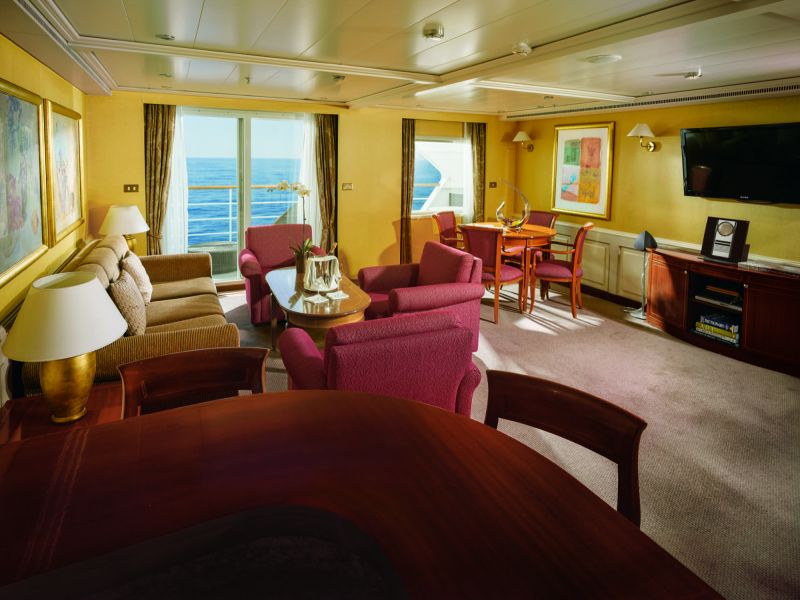
| Grade Code | From | To | |
| R1 | Royal Suite (1 Bedroom) | £28,300 | £29,000 |
| R2 | Royal Suite (2 Bedrooms) | £39,100 | £40,500 |
Stately describes the Royal Suite. Commanding and majestic. Perfect for entertaining. Enough living space to roam. The pinnacle of good living. Available as a one-bedroom configuration or as two-bedrooms (as illustrated) by adjoining with a Veranda Suite.
One bedroom: 90-94 sq.m. including veranda
Two bedroom: 126 sq.m. including veranda
Please note that the 3rd guest will sleep on a comfortable sofa bed in the reception area of the suite.
Essentials
Characteristics
Furniture
Media & Communication
Onboard Services
Amenities
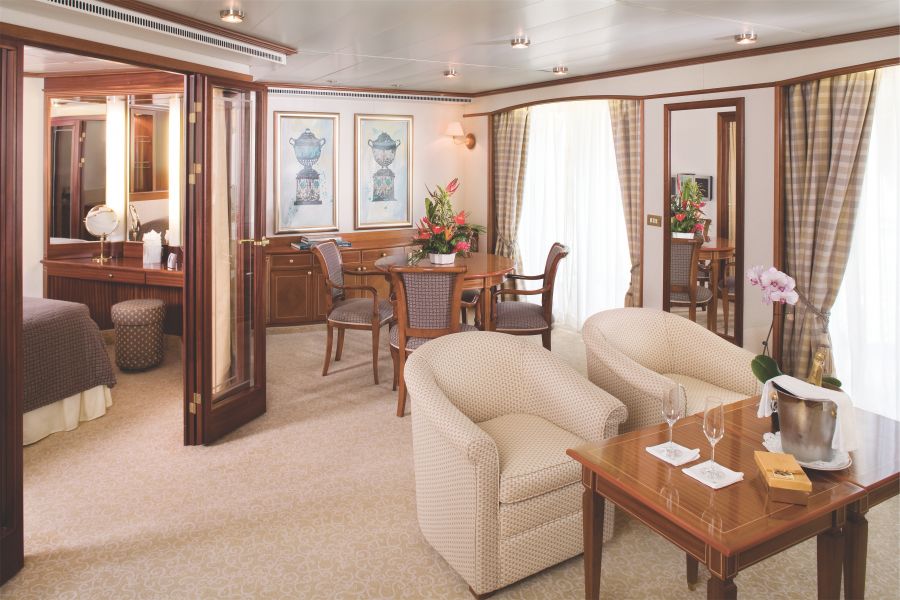
| Grade Code | From | To | |
| SL | Silver Suite | £25,400 | £26,100 |
Stylish and sophisticated. Separate dining and living rooms. Larger verandas. Situated midship. Perfection in design for comfortable living. Silver Suites accommodate three guests.
One bedroom: 61-65 sq.m. including veranda
Please note that the 3rd guest will sleep on a comfortable sofa bed in the reception area of the suite.
Essentials
Characteristics
Furniture
Media & Communication
Onboard Services
Amenities
The images shown are for illustration purposes only and may not be an exact representation of what you find on the ship.

Authentic Italian recipes and the freshest, sustainable ingredients come together in this restaurant at sea.
On board this luxury cruise ship a divine selection of Italy’s best cuisine is served à la carte in La Terrazza. Authentic recipes and the freshest ingredients come together with flair and passion aboard this luxury cruise — a flavourful expression of Silversea’s distinctive Italian heritage. La Terrazza uses buffalo mozzarella from Naples, organic balsamic vinegar and olive oil from Umbria, and air-dried ham out of Parma. The Emilia-Romagna region also produces Silversea’s 24-month aged Parmigiano Reggiano, while the pasta is made daily right on board.
Open seating for breakfast and lunch.
Reservations required for dinner.

Enjoy Continental and regional specialities, as well as sweeping ocean views in our main dining room.
Sparkling with silver, crystal and candlelight, Silversea’s main dining room serves contemporary, international cuisine with sophisticated elegance and impeccable service. Menus feature regional specialities unique to the voyage destination, for example, Roasted Chilean Sea Bass while cruising the Chilean fjords and Indian Chicken Korma en route to Mumbai. The Restaurant aboard this luxury cruise ship offers open-seating dining, which means there are no assigned times, no assigned tables. You are free to dine when, where and with whom you please.
The images shown are for illustration purposes only and may not be an exact representation of what you find on the ship.
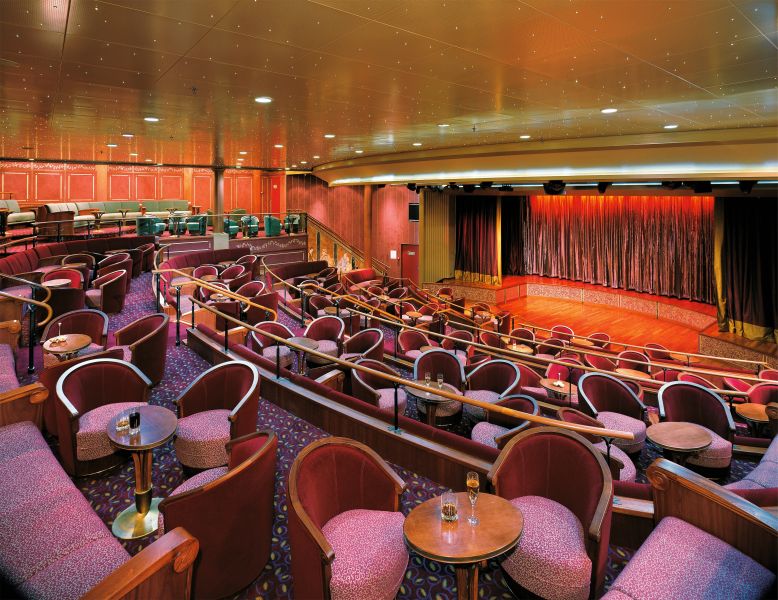
Applaud a broad spectrum of entertainment — from full-scale production shows and classical soloists, to cultural entertainment and feature films.
Every seat in this multi-tiered venue enjoys a clear view to the stage. Applaud a broad spectrum of entertainment presented during the cruise — from full-scale production shows and classical soloists, to cultural entertainment and feature films. Throughout your voyage, the luxury cruise ship’s The Show Lounge also presents port talks, enrichment lectures and a variety of special events.
The images shown are for illustration purposes only and may not be an exact representation of what you find on the ship.
The images shown are for illustration purposes only and may not be an exact representation of what you find on the ship.
| 17 nights aboard the Silver Shadow | |||
| Butler Service in Every Suite | |||
| Gratuities Always Included | |||
| Beverages In-Suite and Throughout the Ship | |||
| Gourmet Dining | |||
| In Suite Dining & 24-Hour Room Service | |||
| Intimate small size ships | |||
| Free Wifi Throughout the Ship | |||
| Free Zodiac, Land and Sea Tours & Activities & Complimentary Expedition gear | |||
| Port Taxes and Fees | |||
 | ABTA and ATOL Protection* | ||
Date 2nd Apr 2028 |
Nts 17 |
Suite £9,900pp |
Date 2nd Apr 2028 |
Nts 17 |
Suite £9,900pp |
| Suite staterooms from | £9,900pp | ||
| G1 | Grand Suite (1 Bedroom) |  | |
| G2 | Grand Suite (2 Bedrooms) |  | |
| ME | Medallion Suite |  | |
| O1 | Owner's Suite (1 Bedroom) |  | |
| O2 | Owner's Suite (2 Bedrooms) |  | |
| R1 | Royal Suite (1 Bedroom) |  | |
| R2 | Royal Suite (2 Bedrooms) |  | |
| SL | Silver Suite |  | |
| VI | Vista Suite | £9,900pp | |
| CV | Classic Veranda Suite | £11,500pp | |
| DX | Deluxe Veranda Suite | £12,600pp | |
| SV | Superior Veranda Suite | £12,000pp | |
Fusion Cruises when selling travel arrangements is a trading name of The Midcounties Co-operative Ltd. Fusion Cruises is an Accredited Body Member of Midcounties Co-operative Travel Consortium. (ABTA:P6652, ATOL:6053).
Book with Confidence. We are a Member of ABTA which means you have the benefit of ABTA’s assistance and Code of Conduct.
Some of the flights and flight-inclusive holidays on this website are financially protected by the ATOL scheme but ATOL protection does not apply to all holiday and travel services offered on this website. This website will provide you with information on the protection that applies in the case of each holiday and travel service offered before you make your booking. If you do not receive an ATOL Certificate then the booking will not be ATOL protected. If you do receive an ATOL Certificate but all parts of your trip are not listed on it, those parts will not be ATOL protected. Please see our booking conditions for information, or for more information about financial protection and the ATOL Certificate go to: www.caa.co.uk
